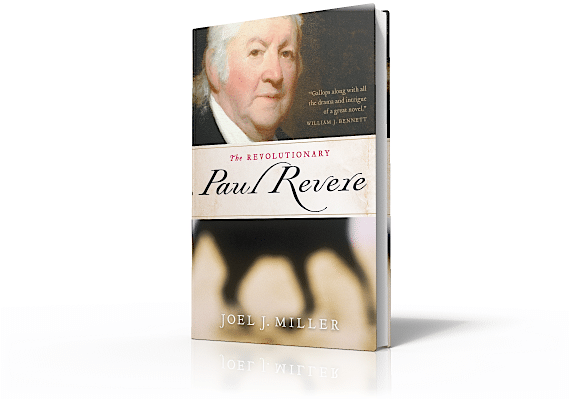When we think of leaders from America’s revolutionary era, our minds jump to military commanders like George Washington, political organizers like Samuel Adams, and rousing orators like Patrick Henry. In the hierarchy of the Revolution, these men stand atop the loftiest rungs. For good reason.
These men accomplished amazing feats against incredible odds. But they could not have done it alone. Like executives in a successful company, they required the service and sacrifice of others to achieve their goals. They required effective lieutenants—people like Paul Revere.
Everyone knows Revere for his famous ride. Most are, however, unaware of the vital “midlevel” leadership roles and functions that he played in the buildup to Independence. In researching his life for The Revolutionary Paul Revere, I found four tactics that made Revere indispensable to America’s revolutionary efforts—tactics that can also make you indispensable in your organization.
1. Take the Initiative
Revere was a blue collar guy, an artisan. Unlike other revolutionary leaders like John Adams or John Hancock, he received a minimal education and was entitled to none of life’s higher stations in colonial Boston, his hometown. That didn’t stop him from serving the cause. He led from where he was.
A goldsmith by trade, Revere led where he was able. One example: During the British military occupation of Boston following the Tea Party, who helped to organize a spy ring of workaday patriots to keep tabs on the redcoats and their commanders? None other than Revere—repairman of silverware by day, cloak-and-dagger coordinator by night.
Anyone can fill time and work a to-do list. Taking the initiative to lead is what sets apart someone truly valuable to an organization.
2. Leverage Your Strengths
Everyone brings unique talents to their situations, because everyone’s unique. The trick is in leveraging those strengths. Revere was a sociable fellow; he joined several different local clubs and associations and could regularly be found in the taproom of the Salutation or Green Dragon taverns. Connectedness was one of Revere’s strengths. So he used it.
Historian David Hackett Fischer sorted the membership lists of seven different Boston political groups and associations. He found 255 members in all, of whom 94.1 percent were in just one or two groups. And at the other end of the spectrum? Only Revere and his friend Joseph Warren belonged to more than four groups—in fact, each was a member of five different groups. Revere’s network made him useful as someone who could link disparate revolutionary parties, and his connectedness applied in other areas as well, including his role as an express rider.
Whatever your unique strengths, leveraging them in a leadership capacity increases your worth to your organization—especially if you excel at the third tactic.
3. Be Reliable
When Sam Adams needed someone to send word to New York that Boston patriots had just dumped several hundred crates of tea in Boston Harbor, he sent Revere—who was also one of the likely participants in the destruction of the tea.
That was 1773. He served as an express rider through start of the war in 1775. In one of countless messages Revere carried to New York during this period, Boston patriot Thomas Young referred to Revere as “Steady, vigorous, sensible, and persevering.” Whether it was riding express or printing money or casting cannons or even figuring out how to manufacture gunpowder, Revere was tapped time and again because patriot higher-ups could count on him to get the job done, whatever it was and even if he’d never done it before, which oftentimes he had not.
That last fact highlights Revere’s strength at creative problem solving, something he reliably leveraged every day. It’s also one area that every leader at any level in an organization should cultivate.
4. Cultivate Creativity
Human creativity is life’s only truly renewable resource. The more you use it, the more you get. In his business life, Revere was constantly creating and developing new methods, fresh approaches, and ingenious applications. He transferred that facility into the patriot movement. Whether it was unknotting technological problems for the patriots or coordinating communications, Revere reaffirmed his value at every turn.
Take the ride for which he's famous. Revere realized that if the British were to seize the powder stores at Concord, they might try to lock down Boston to prevent any word about the assault from spreading. Revere’s job was to spread the news, so coming home through Charlestown several days before his fabled ride and the Battle of Lexington and Concord, he contrived the one-and-two lamp signal from North Church tower. That way if he were unable to get back to Charlestown, the patriots there could still get the news and spread the alarm.
Revere’s fears proved true. When the Brits did move, they seized almost every boat in town and placed sentries along the roads. Revere was able to get out by one of the few undiscovered boats, but the people in Charlestown already knew about the troops when Revere arrived because he’d charged someone with hanging the lights in the tower. The solution worked.
If it’s true that most of a leader’s job involves problem solving, then one of the most important things you can do as a leader is to follow Revere and cultivate creativity in the endeavor.
Disclosure of Material Connection: Some of the links in the post above are “affiliate links.” This means if you click on the link and purchase the item, we will receive an affiliate commission. Regardless, we only recommend products or services we use and believe will add value to our readers. We are disclosing this in accordance with the Federal Trade Commission’s 16 CFR, Part 255: “Guides Concerning the Use of Endorsements and Testimonials in Advertising.









